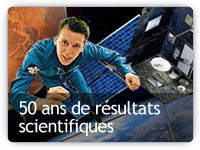

In the early 60's, the first American meteorological satellites appeared. Those circumpolar satellites completed the traditional means of meteorological previsions but scientific opinion was divided about the relative quality of the satellite remote sensing and the direct measurements in the atmosphere to create a reliable weather forecast.
The Eole project by CNES to address the scientific concerns of the French and American meteorologists, required the development of balloons profoundly different from the currently used, i.e. open stratospheric balloons suitable for short-length scientific experiments in aeronomy, aerology, astronomy, astrophysics, geophysics and biology. This type of balloons could not afford the cooling related to the night and day transition so they could not fly more than 24 hours.
In the Eole case, the objective was to have those balloons flying during weeks and months. To do so, airtight balloon envelopes had to be developed and they had to resist an important inner pressure, i.e. they had to be able to contain enough helium to maintain the balloon inflated in all circumstances.

The first campaign of EOLE balloons
The Eole project combined a flotilla of balloons drifting in the Southern hemisphere with a satellite in charge of localizing the balloons and collecting the pressure and temperature measurements. Stations on the ground gathered those information and sent them to a processing centre.
The Eole's objective was ambitious: covering the austral atmosphere for a month with a flotilla of at least 300 in-flight balloons.
The first over-pressurized balloon campaign carried out by French experimentalists took place in July 1966 from the Tontouta airport, New Caledonia. Several more followed. The main campaign included 480 balloons with a direct link to the satellite. More than sixty of them were followed in-flight during more than six months and fourteen during more than a year.
The exceptionally uniform and dense data gathered by the Eole experiment particularly confirmed that the atmospheric circulation presented very low vertical speeds compared with the horizontal winds. This two-dimensional characteristic implied a considerably enhanced level of predictability compared with the ordinary three-dimensional flows. So it was the theoretical feasibility of one or two weeks meteorological forecasts which was confirmed by the Eole project.
This cooperation between NASA and CNES was the occasion for fruitful exchanges between scientists and for effective collaboration between the engineers of each country. The scientific results (LMD - dynamic meteorology laboratory) allowed a better comprehension of the atmospheric circulation and the dispersion of the energy in the atmosphere. They also made scientists able to calibrate the temperature measurements with those achieved by the american TIROS satellites.
The technical results were, at least, as convincing. The interest and the performance of the localization were confirmed by better results than expected. Great progress were achieved in the pressurized balloon making process and in the beacon technology. Like with all innovative projects, we can find Eole's spin-offs in a lot of posterior programs about location-collection and long-length balloons.
Bibliographic references
Les ballons au service de la recherche, l’aérostation des origines à nos jours under the direction of André Lebeau and Jean-Pierre Sanfourche, foreword of Yannick d' Escatha, Edite 2011
And after Eole?
Les suites du projet Eole from CNES on Vimeo.
Contacts
- Scientific contact: Pierre Morel
- Atmosphere program scientist: Philippe Veyre